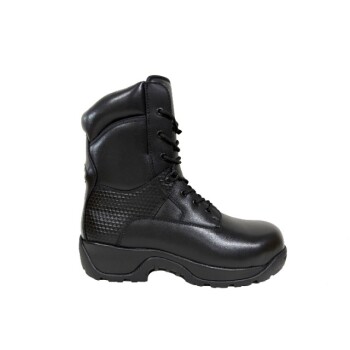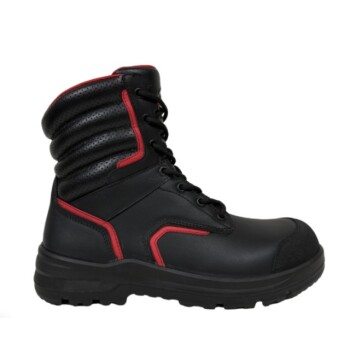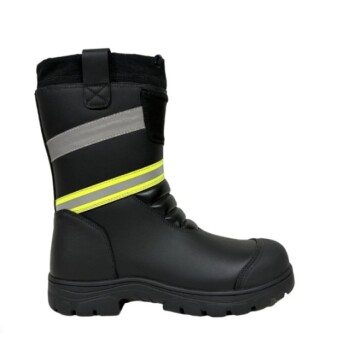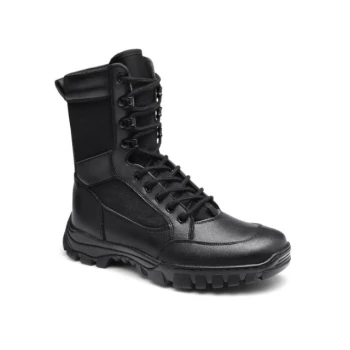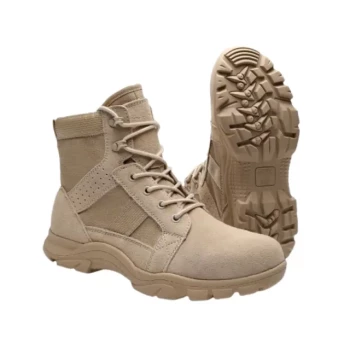At a glance, the core difference is one of purpose: riding boots are specialized safety equipment, while dress boots are fashion items. A true riding boot is built from thick, durable leather with a distinct heel and sole designed for safety and communication with a horse. A dress boot prioritizes aesthetics, using finer materials and construction suited for walking, not interacting with a 1,200-pound animal.
The fundamental distinction is that a riding boot is a piece of functional equipment designed for a specific task, while a dress boot is a fashion accessory. Using one for the other's purpose compromises both performance and safety.
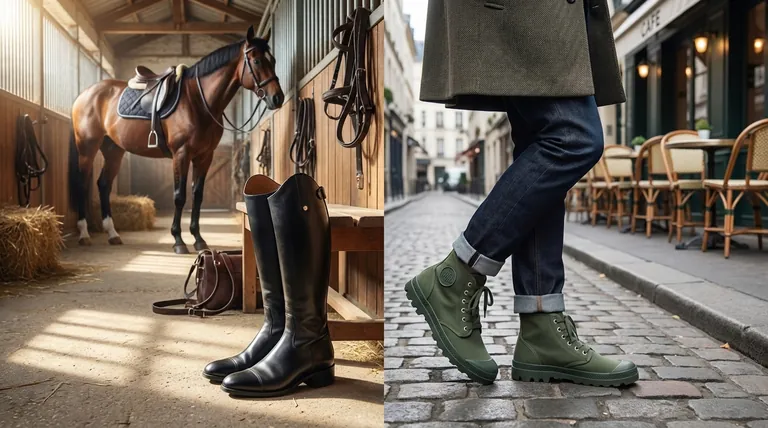
The Anatomy of a Purpose-Built Tool: The Riding Boot
A riding boot is not simply a tall boot; every element of its design serves a critical function related to being in a saddle.
Uncompromising Material and Construction
Riding boots are made from heavy-duty leather designed to withstand the friction and abuse of the saddle, stirrup leathers, and general barn life. The tall shaft protects the rider's leg from being pinched or chafed.
The Non-Negotiable Safety Heel
Every legitimate riding boot has a pronounced heel, typically at least one inch high. This is a critical safety feature that prevents the rider's foot from accidentally slipping all the way through the stirrup, which could lead to a serious accident.
The Protective Shaft
The tall, snug-fitting shaft of a riding boot serves two purposes. It provides a smooth surface against the saddle for clear communication and protects the rider's leg from the saddle's leather flaps.
Deconstructing "Riding Boots": A Tale of Two Disciplines
The term "riding boot" is not monolithic. It primarily breaks down into two categories—English and Western—with important sub-types within the English style.
English Field Boots: Flexibility for Jumping
Used by hunter, jumper, and equitation riders, field boots are defined by their lacing at the ankle. This design allows for greater ankle flexibility, which is necessary for the shorter stirrup length and "heels-down" position required for jumping.
English Dress Boots: Rigidity for Dressage
Dress boots (or dressage boots) have no laces and present a clean, formal silhouette. They are crafted from much stiffer leather to support a long, straight leg position, helping the rider give subtle aids to the horse in the discipline of dressage.
Western "Cowboy" Boots: A Different Design for a Different Task
Western boots are distinct from their English counterparts. They feature a higher, often angled "Cuban" heel, a shorter and looser-fitting shaft, and a more pointed or rounded toe, all designed for the specific needs of the Western riding saddle and style.
The Domain of Style: The Fashion Dress Boot
When not referring to the specific "dressage" boot, a dress boot is any boot designed primarily for its aesthetic contribution to an outfit.
Prioritizing Form Over Function
Fashion dress boots often use thinner, more supple materials that are comfortable for walking but would quickly wear out from the rigors of riding. Their soles are typically smoother and may be made of leather, which offers poor grip in a stirrup.
A Nod to Practicality
Some high-quality dress boots, often inspired by historical military footwear, are built for durability. They may feature strong leather uppers and double leather or rubber soles, making them excellent for outdoor walking. However, they still lack the specific safety heel and protective shaft of a true riding boot.
Understanding the Trade-offs
Confusing the two types of boots can lead to significant issues with safety, comfort, and the longevity of your footwear.
Can You Wear Fashion Boots for Riding?
It is highly inadvisable and unsafe. A fashion boot's lack of a proper safety heel creates a serious risk of your foot slipping through the stirrup. Furthermore, the materials are not designed to protect your leg or withstand the wear and tear of the sport.
Can You Wear Riding Boots for Everyday Fashion?
Yes, but with caveats. Riding boots, especially stiff dressage boots, are not designed for extensive walking and can be uncomfortable. Their specialized construction is overkill for daily wear, but their classic silhouette is often adopted by fashion.
Making the Right Choice for Your Purpose
Your final decision must be guided by your primary activity.
- If your primary focus is equestrian safety and performance: You must choose a boot designed for your specific riding discipline (Field, Dress, or Western).
- If your primary focus is creating a polished or stylish look for daily wear: Choose a fashion dress boot, as it offers superior comfort and aesthetic versatility for walking.
- If your primary focus is a rugged, outdoor aesthetic without riding: A durable, military-inspired dress boot with a rubber sole is an excellent choice, but it should never be used for equestrian activities.
Understanding this distinction between a functional tool and a fashion statement ensures you have the right boot for the right job.
Summary Table:
| Feature | Riding Boots | Dress Boots |
|---|---|---|
| Primary Purpose | Equestrian Safety & Performance | Fashion & Daily Wear |
| Heel | Pronounced safety heel (≥1 inch) | Variable, often lower or flat |
| Materials | Heavy-duty, durable leather | Softer, finer, or fashion leathers |
| Sole | Designed for stirrup grip | Designed for walking comfort |
| Leg Protection | Tall, protective shaft | Varies, not designed for saddle wear |
Need high-quality boots manufactured for your brand or business? As a large-scale manufacturer, 3515 produces a comprehensive range of functional riding boots and stylish dress boots for distributors, brand owners, and bulk clients. We ensure the highest standards of safety, durability, and style. Let's discuss your specific requirements and bring your footwear vision to life. Contact our team today for a consultation!
Visual Guide
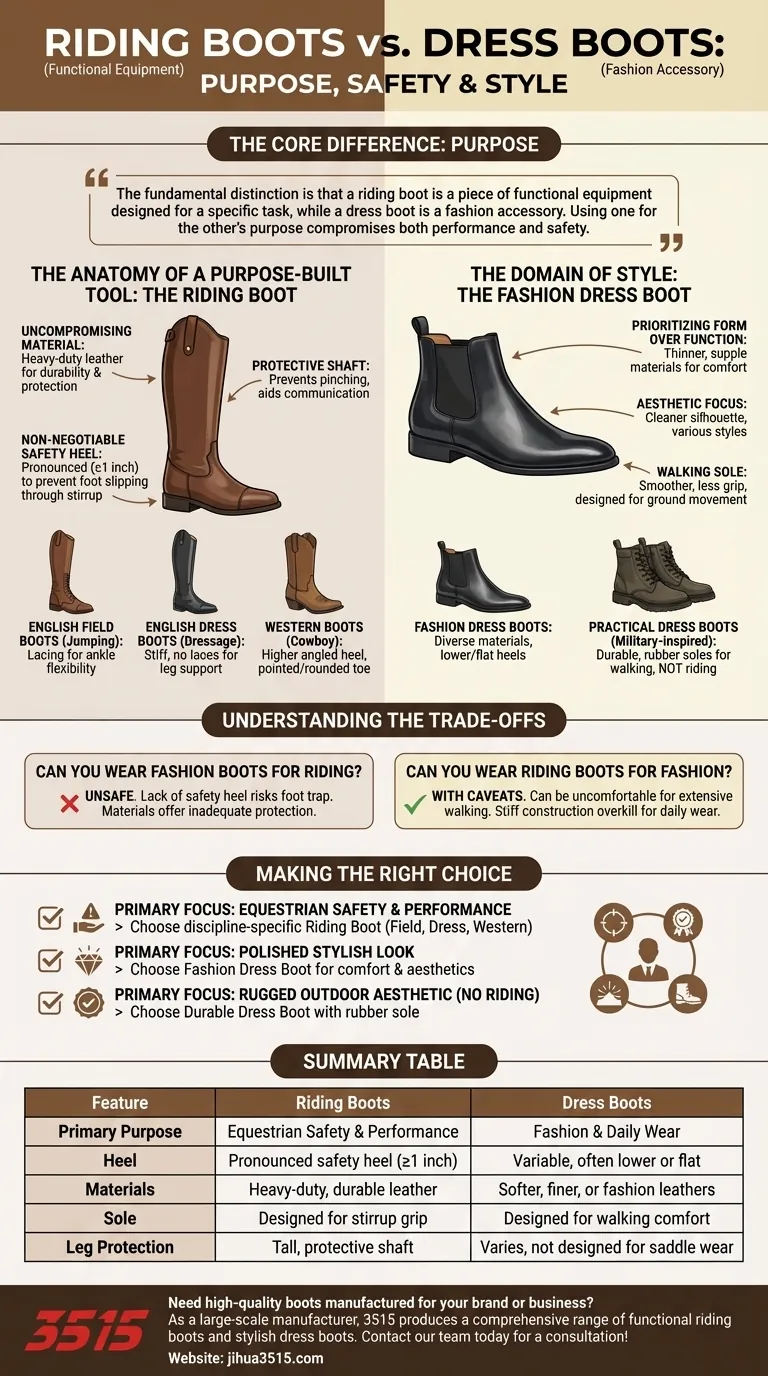
Related Products
- Factory-Direct Wholesale Canvas Boots with High-Traction Rubber Soles
- Safety Footwear Wholesale Manufacturer for Custom OEM/ODM Production
- Wholesale High-Traction Camo Boots - Custom Manufacturer for Brands
- Factory Direct Wholesale Rain Boots Durable Waterproof & Fully Customizable
- Customizable Anti-Smash Safety Boots for Wholesale & Private Label Manufacturing
People Also Ask
- Why is rubber commonly used for non-slip soles? The Science of Superior Grip
- Why are rubber soles beneficial in cold-weather boots? Superior Traction & Waterproofing
- What is a vulcanized sole? Discover the Secret to Superior Flexibility and Grip
- What are the advantages of rubber soles in safety boots? Unbeatable Grip & Durability
- What types of work environments are hiker-style rubber outsoles best for? Ideal for Outdoor & Industrial Safety





